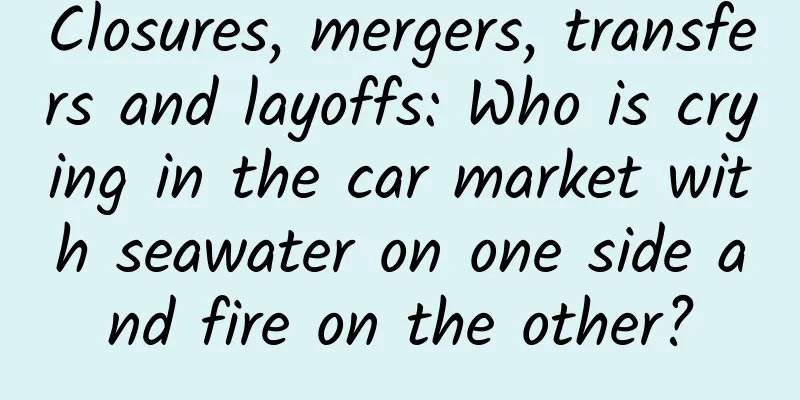Closures, mergers, transfers and layoffs: Who is crying in the car market with seawater on one side and fire on the other?

|
According to the China Passenger Car Association, China's passenger car retail sales in July reached 1.72 million units, down 2.8% year-on-year and 2.6% month-on-month. The data is not very good, but it is not easy to come up with such a report card in the traditional off-season of July. At the same time, two other sets of data are also worth noting. In July, the cumulative sales of domestic brands reached 1.06 million units, a year-on-year increase of 13%, and the domestic market share soared to 61.8%; in July, the sales of new energy passenger vehicles reached 878,000 units, a year-on-year increase of 36.9%, and the penetration rate increased to 51.1%, of which the market share of domestic brands exceeded 90%. It is obvious that the market has begun to reach a crossroads with sea water on one side and fire on the other. Some people are rising to the top, while others are waving goodbye; some manufacturers are drinking and eating meat with great pleasure; while some manufacturers are secretly grieving in the corner of the market, with bad news of factory closures and layoffs coming one after another. In June, Nissan announced the closure of its Changzhou plant with an annual production capacity of 130,000 units, cutting its production capacity in China by 10%. It is worth noting that the Nissan Changzhou plant has a short history, with the first car officially rolling off the production line in November 2020. Honda said that the Changzhou plant was not completely closed but "suspended production" and the production task of the Qashqai model originally undertaken was transferred to the Dalian plant. At the same time, Dongfeng Nissan's Wuhan Yunfeng plant is also adjusting to the direction of electric vehicles. Previously, the plant mainly produced two models, the X-Trail and the Arrival, but the sales of these two models have been sluggish, and a large amount of production capacity has been idle, so the production shift is not surprising. On July 25, Honda Motor said it would close its two factories in Guangzhou and Wuhan in the fourth quarter of this year, cutting about 50% of its production capacity in China. However, judging from Honda's current sales, this number is likely to be further "cut". It is reported that Honda is preparing to further reduce its production capacity in China by about 200,000 vehicles, and has entered the early coordination stage. Toyota, the leader of Japanese manufacturers, is also having a hard time. It even began to cut production in November 2023. In March of this year, the historic FAW TEDA factory stopped production by taking a long holiday. The TEDA plant has been in production for 21 consecutive years. The Crown, Reiz and Corolla we are familiar with all come from this plant. In 2022, the plant still had a production capacity of 620,000 vehicles, but by 2023, the situation took a sharp turn for the worse and only 204,000 vehicles were left. In fact, as early as the beginning of 2023, there was news that the second production line of the TEDA factory was sold to BYD. Although it has not been officially confirmed, it is an indisputable fact that a large amount of Toyota's production capacity in China is idle. In fact, the three Japanese giants are relatively resistant to risks, while some weaker joint venture manufacturers have already started selling off their products. Take Beijing Hyundai as an example. It once had five major production bases in China, but the Beijing No. 1 factory and the Chongqing factory have been sold, and the Beijing No. 2 factory is also idle. In 2022, Dongfeng Peugeot Citroen Automobile's second factory was resold to Dongfeng Honda, and in 2023, Dongfeng Peugeot Citroen's third factory was sold to Dongfeng Group; in 2023, GAC Mitsubishi's Changsha factory was transferred to GAC Aion. The fact that there has been no news of joint venture manufacturers stopping operations or closing factories does not mean that nothing has happened, there is just no news. SAIC-GM's total production capacity in China is 2.6 million vehicles, but its sales in 2023 were only 1 million vehicles. In the first half of this year, sales plummeted to 255,000 vehicles, and its capacity utilization rate is less than 25%. The same is true for Volkswagen, which has a production capacity of 5.4 million vehicles in China, but its sales in China in 2023 were only 3.236 million vehicles, and there were also a lot of idle vehicles. Although they did not directly cut production capacity like Japanese manufacturers, they faced the same dilemma. In addition to production cuts, there are also layoffs. On April 15, Tesla announced a 10% global layoff, with some departments in Tesla China even cutting more than 30% of their employees. Soon after, Ford China announced layoffs, with the number of layoffs expected to exceed 1,300. In May, GAC Honda launched a layoff plan of about 1,000 people. It should be noted that it is not only foreign manufacturers that are in trouble. Domestic manufacturers are also undergoing tremendous changes, especially new energy vehicle manufacturers. Many domestic manufacturers have been left stranded. Among the domestic new power brands, HiPhi Auto has already entered the bankruptcy period. Since its establishment, it has never sold more than 5,000 vehicles a year. Another new car-making powerhouse in a similar situation to HiPhi is Polestar, a brand jointly created by Geely and Volvo. In early January, it announced a global layoff of 450 employees, accounting for about 15% of the total number of employees. It seems that even with the support of Geely and Volvo, Polestar is not having an easy time. In March, Great Wall Motors reported that a large number of employees resigned after the Spring Festival, including some who had worked at the company for more than 10 or even 20 years. In addition, it was also reported online that Great Wall Motors was laying off employees in disguise by forcing non-local employees to transfer to Baoding. Also in March, news began to circulate in the market that SAIC's Feifan Auto had laid off 70% of its employees, of which the high-end intelligent driving team had been completely laid off. There was even news that Feifan Auto would no longer exist as an independent brand. Although these news were denied by Feifan officials, a look at Feifan Automobile's dismal sales will reveal that even if it can hold on without layoffs now, it may have to go down this path in the future. After the May Day holiday, Ideal Auto began a new round of internal personnel optimization, commonly known as "layoffs", with a layoff rate of more than 18%, involving multiple departments of Ideal Auto and causing about 6,000 people to lose their jobs. On August 6, news of Evergrande Auto's layoffs spread in the market, involving multiple departments including production and R&D. In fact, there is another group of layoffs among new car manufacturers in China that has not attracted much attention. The reason is very simple. Many of these manufacturers not only lost their factories, but even their bosses ran away, so it cannot be called "layoffs." Most of the news about factory closures and layoffs came from joint ventures, while the hardest hit among domestic brands were new car manufacturers. This shows that during the rapid transformation of the market, there will always be car manufacturers that cannot keep up with the times and will be left behind. Joint ventures are closing factories and laying off employees mainly because of their poor market performance. For an automobile manufacturer, if sales cannot be increased, everything else is just empty talk. Data from the China Passenger Car Association shows that the sales volume of mainstream joint venture brands in China in July was only 440,000 vehicles, a year-on-year decrease of 25%; the situation in the new energy market was even worse. In July, brands other than Chinese brands accounted for about 10% of the new energy market, of which 5.3% was contributed by Tesla. As fuel vehicle sales continue to shrink and new energy vehicles fail to capture the incremental growth, joint ventures have been shutting down, merging and reorganizing. Of course, there are still differences between different manufacturers. For some manufacturers, once they close their factories, it will be difficult to come back, such as Beijing Hyundai, which has been squeezed into a corner, and Ford, which has already "laid down" in the field of new energy. Some other manufacturers are making strategic adjustments. Japanese car manufacturers are a good example. While closing factories, they are also quietly expanding their new energy production capacity. Take Honda Motor as an example. It has basically cut its production capacity of fuel vehicles, but at the same time it is also preparing to build two new electric vehicle factories, which may increase its production capacity by 500,000 vehicles by the end of 2024. The situation of layoffs at domestic automakers seems to be better. Great Wall and Ideal are not in serious trouble, and layoffs will not cause serious damage. As for new brands such as HiPhi, Evergrande, and Feifan, they originally had unstable foundations and were the products of blindly "launching projects" under the tide of new energy. It is normal for them to disappear from the market. Competition in the auto market is a marathon. It is not the first time that a wave of factory closures and layoffs has occurred in the history of China's auto industry. It is normal for manufacturers to have ups and downs in their business conditions. For well-established joint ventures and domestic mainstream new energy manufacturers, factory closures and layoffs are indeed a crisis, but there is also hope. The key question is whether they can keep up with the times. As a winner of Toutiao's Qingyun Plan and Baijiahao's Bai+ Plan, the 2019 Baidu Digital Author of the Year, the Baijiahao's Most Popular Author in the Technology Field, the 2019 Sogou Technology and Culture Author, and the 2021 Baijiahao Quarterly Influential Creator, he has won many awards, including the 2013 Sohu Best Industry Media Person, the 2015 China New Media Entrepreneurship Competition Beijing Third Place, the 2015 Guangmang Experience Award, the 2015 China New Media Entrepreneurship Competition Finals Third Place, and the 2018 Baidu Dynamic Annual Powerful Celebrity. |
<<: Don’t worry if you lose your phone! Apple Pay explained
Recommend
How to check which creative idea is good in Baidu bidding?
(1). Whether the idea is good or not depends main...
Mid-year review | A collection of marketing cases in the first half of 2018!
New media will emerge in an endless stream as tec...
13-year-old boy tested positive for "drugs" twice in a row after having flu! Don't take this kind of drugs randomly!
This winter, respiratory infections continue to b...
Foreign trade promotion: Google bidding promotion or Google optimization?
From the moment you decide to do Google foreign t...
Are the Beijing Winter Olympics commemorative banknotes made of plastic? In fact, the banknotes of these countries are not "paper" either
The ice sports commemorative banknote issued by t...
Dealing with two common problems in iOS development
[[134199]] (I) “Unknown class XXViewController in...
How much does it cost to develop a Jixi Rubber and Plastic Mini Program?
What is the investment cost of Jixi Rubber and Pl...
App overseas promotion, basic process and core elements of activity operation!
First, compared with the traditional manufacturin...
ACEA: European Electric Vehicle Charging Infrastructure Master Plan (72 pages)
EU-27 Electric Vehicle Charging Infrastructure Ma...
《Lao Duan said: Ultra-HD box》
Duan Youqiao, an iQiyi artist, today I suddenly w...
Octopus has parasites?! Octopus: That's my partner's penis...
In 1829, Georges Cuvier, a leading figure in the ...
Solid info! 6 customer acquisition models for APP promotion!
This time, I spent 2 days researching various pop...
Meitu competitive product analysis report!
Photo editing software and photography software a...
Practice: How to use data mining to convince your client?
This article is written at a milestone moment. On...
Besides stress, what else can cause baldness?
I wonder if you have this kind of worry: Why do y...









